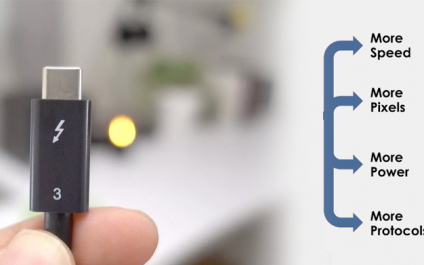
Recently, I was in my home office working on my computer. I have a 27-inch 4K monitor, USB Apple Keyboard, Wireless Mouse, speakers, Logitech webcam, laser printer, and an ethernet connection to my network. You should know, however, that my computer is a 2017 Macbook Pro laptop and the only thing connected to my laptop is a single Thunderbolt 3 cable. Join me in this three-part series, as I dive deep into the awesome journey Thunderbolt 3 has taken and where it’s going.
Part 1: A masterpiece in the making
Thunderbolt 3 (TB3) is an engineering masterpiece. About two years ago, I wrote an article on the arrival of TB3. Despite the fact that Intel unveiled it in 2015, 2016 is when TB3 ports slowly trickled in. Previous versions of Thunderbolt were good, but HDMI, USB, and DisplayPort’s improvements made Thunderbolt look unnecessary. Thunderbolt 3, on the other hand, took the spotlight with its features:
- 40Gbps bandwidth: 2x the amount of Thunderbolt 2 and 4x the amount of USB 3.1
- DisplayPort, HDMI, and USB 3.1 compatibility via cables, adapters, or active TB3 cable
- USB Power Delivery support, allowing data connections while supplying power to a device
- Integrated networking, allowing 10 Gb ethernet connections
- Adopted USB-C port/connector design, which was small, easy, and reversible
Everyone was rooting for TB3 to succeed, but half-way through 2016, manufacturers showed us they were taking a slow and cautious approach to the new technology. Towards the end of 2016, however, Apple shocked the world when they revealed the new Macbook Pros. Their 2016 flagship laptops only came with Thunderbolt 3 ports and one headphones port.
Growing (adoption) pains
To be fair, Apple has a history of making crazy, borderline risky, engineering decisions but very seldom did it dive in this deep and this fast. They were basically forcing customers to solely use ports that the rest of the world was still experimenting with. People everywhere broke out in anger or confusion as they purchased the Macbook Pro they’d been saving up to buy. Apple took a lot of heat while people got accustomed to carrying out a small bag of adapters for everyday needs (like using a simple USB drive). In fact, Apple felt forced offer unprecedented discounts on adapters and cables as a way of easing the outcries and tension.
 The life of dongles for Apple users
The life of dongles for Apple usersI agree that Apple’s bold move was painful for us all, but it was pain that we needed to go through. While others found it easy to criticize their move, there was a growing sense of appreciation from forward-thinking people. We all knew the end results would be positive and appreciated, like months of diet and exercising, or getting your eyes waxed. Apple took it upon itself to pave a road and build a tunnel through Mt. Thunderbolt, an incredible feat no one else was willing to take. Thunderbolt 3 was the future that Apple was bringing to the present.
Thunderous results
 Dell XPS 15 with one TB3 port
Dell XPS 15 with one TB3 portToday, most middle to high-end laptops feature at least one Thunderbolt 3 connection. That is an IT engineer’s dream coming true. The day is coming when all laptops and computers will only utilize TB3 ports, just like Macbook Pros do today. As the port continues to be adopted, more monitors, peripherals, devices, and accessories, will follow suit.
 LG Ultrafine monitors use TB3 connections
LG Ultrafine monitors use TB3 connectionsRight now, the port has a lot of power requirements and a licensing fee. That makes it difficult to implement on everyday IT items like a $50 hard drive or a $30 wired keyboard. Overtime, I can see manufacturing and licensing costs go down as it gets wider adoption.
Keep your eye out for the next installment of “The State of Thunderbolt 3,” Peripheral Power-Equipment Efficiency.




